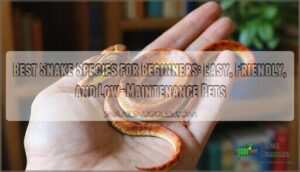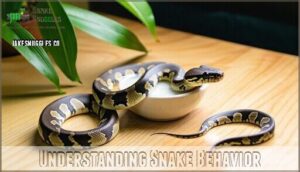This site is supported by our readers. We may earn a commission, at no cost to you, if you purchase through links.
 If you’re a first-time snake owner, the best snake species for beginners include corn snakes, ball pythons, and Kenyan sand boas.
If you’re a first-time snake owner, the best snake species for beginners include corn snakes, ball pythons, and Kenyan sand boas.
They’re calm, easy to handle, and adapt well to captivity.
Corn snakes are like the golden retrievers of the snake world—friendly, hardy, and low-maintenance, while ball pythons are famous for their relaxed, “curl-up-and-chill” attitude.
Kenyan sand boas are equally beginner-friendly with a smaller size and simple care needs.
These species eat pre-frozen rodents, thrive in small enclosures, and aren’t too picky about humidity or temperature.
With the right care, owning a snake can be a rewarding and stress-free experience.
Table Of Contents
- Key Takeaways
- Choosing The Right Snake
- Beginner-Friendly Snake Breeds
- Essential Snake Care Requirements
- Understanding Snake Behavior
- Snake Diet and Nutrition
- Health and Hygiene
- Creating a Snake-Friendly Environment
- Handling and Interacting With Snakes
- Common Beginner Mistakes
- Long-Term Commitment and Responsibility
- Frequently Asked Questions (FAQs)
- What are the best pet snakes for beginners?
- How do I choose a pet snake?
- Are king snakes good pets for beginners?
- Which snakes are the easiest to take care of?
- Are beginner-friendly snakes easy to care for?
- What snakes are easy to care for?
- What is the best snake to start with?
- What are the friendliest snake breeds?
- What is the most chill snake to own?
- What is the most cuddly pet snake?
- Conclusion
Key Takeaways
- Choose calm and hardy snakes like corn snakes, ball pythons, or Kenyan sand boas for an easy start.
- Set up a proper enclosure with hiding spots, controlled temperature, and substrate matching the species’ needs.
- Feed appropriately-sized frozen rodents to avoid stress, and handle your snake gently to build trust.
- Plan for the long haul, including costs like food, heating, enclosures, and a potential 20+ year commitment.
Choosing The Right Snake
Picking the right beginner snake means balancing their care needs with your lifestyle and experience.
Choosing a beginner snake is about finding the perfect match between their care needs and your lifestyle.
Focus on species that are calm, hardy, and easy to handle to guarantee a positive start to your reptile journey.
Researching Snake Species
Researching snake species is a fun exploration into their natural habitat, diet, lifespan, and care needs.
Look for beginner snakes like corn snakes, admired for their docile behavior and easy care.
Consider species identification, morph variations, and conservation status too.
Knowing their evolution helps you understand their habits, making easy snake care manageable.
Remember: planning makes for a comfy home!
Many beginners find success by understanding snake temperaments.
Considering Temperament and Handling
Considering a snake’s personality is vital. Some breeds, like corn snakes, are gentle, while others show defensive behaviors.
Follow these steps to handle snakes safely:
- Choose docile snake breeds with low bite risk.
- Handle nonaggressive snakes frequently for trust building.
- Learn a snake temperament guide to recognize stress signs.
- Stick to calm, slow movements while handling snakes.
This approach will help ensure a safe and enjoyable experience with your pet snake, by understanding and respecting its temperament.
Evaluating Cost and Lifespan
Snakes live surprisingly long, making them a steady part of your life.
But costs matter too! Think of the initial investment—snake price, enclosure, heating, and decor—and the long-term expenses like food, substrate, and veterinary costs.
Here’s a quick breakdown of some beginner snake species:
| Snake Species | Price Range | Lifespan |
|---|---|---|
| Ball Python | $40-$100 | 20-30 years |
| Corn Snake | $40-$80 | 15-20 years |
| Kenyan Sand Boa | $50-$120 | 15-20 years |
Assessing Your Experience Level
Think about your experience level before getting your first snake.
A Self-Assessment Checklist helps: Are you comfortable with snake handling and snake care tips?
Do you have the time commitment, budget planning, and space?
If reptile experience is new for you, starter options like beginner snakes with calm temperaments—such as ball pythons—are the best pet snakes to keep in mind.
Beginner-Friendly Snake Breeds
When you’re new to snake keeping, choosing a species that’s calm, hardy, and easy to care for is key.
Certain breeds, like corn snakes and ball pythons, are perfect for beginners thanks to their manageable size and gentle temperament.
Corn Snakes and Ball Pythons
Corn snakes and ball pythons are two of the most beginner-friendly pet snakes. Both species are hardy, easy to care for, and have docile temperaments, making them popular choices for first-time owners.
Corn snakes and ball pythons are perfect for beginners—hardy, calm, and easy to care for, ensuring a stress-free reptile experience.
Corn snakes are active and curious, while ball pythons are more relaxed and calm. Corn snake morphs offer vibrant colors and patterns, perfect for someone who loves visual variety. Ball python morphs, on the other hand, come in striking designs like pied or banana.
Here’s what you’ll need to keep them happy:
- Enclosure Enrichment: Include hides, climbing branches, and proper substrate for exploring.
- Temperature and Humidity: Maintain basking spots around 90°F and proper humidity levels.
- Feeding Routine: Offer frozen-thawed rodents weekly. They’re both easy eaters.
- Handling Needs: Handle gently but frequently to build trust.
- Breeding Potential: Consider learning about morph genetics if interested.
Corn snakes and ball pythons are truly rewarding beginner snake choices.
Hognose and Kenyan Sand Boas
When exploring beginner snakes, Hognose snakes and Kenyan sand boas stand out for their charm.
Hognose morphs add variety, while their playful defensive behaviors like hooding or playing dead keep them fascinating.
Kenyan sand boas are masters of burrowing into enclosure substrate, often hiding out of sight.
Both species thrive in small tanks with warm temperature gradients, making them low-maintenance.
Their feeding habits vary—Hognose snakes might prefer live or scented prey, while Kenyan sand boas usually accept frozen-thawed rodents.
These manageable snakes make reptile ownership enjoyable.
Garter and Dekay’s Brown Snakes
Curious about beginner snakes with unique charm? Garter snakes and Dekay’s brown snakes are perfect for you.
These small snake species are loved for their simplicity and docile demeanor:
- Natural Habitat: Garter snakes thrive in semi-aquatic settings, while Dekay’s brown snakes prefer simple, moist enclosures.
- Feeding Habits: Garter snakes enjoy fish, rodents, and worms; Dekay’s brown snakes stick to insects and snails.
- Temperament Differences: Both are gentle, though garter snakes may musk when stressed.
- Enclosure Design: Keep tanks secure, with hiding spots.
Essential Snake Care Requirements
Taking care of a pet snake means meeting its basic needs, like the right enclosure size, temperature, and humidity.
You’ll also need to provide hiding spots and enrichment to keep your snake healthy and comfortable.
Enclosure Size and Temperature
Creating a cozy snake habitat starts with the right tank dimensions. Choose a snake enclosure at least two-thirds your snake’s length.
Temperature gradients are essential—use heat sources like heating pads or lamps to create a warm basking spot while keeping the cooler side comfortable. Snake heating works best with thermostat control to avoid overheating.
Appropriate enclosure products are available online. Keep substrate deep enough for burrowers and verify proper ventilation.
A well-regulated temperature gradient transforms your snake’s tank into a stress-free, snug environment.
Lighting and Humidity Requirements
Let’s shed some light—literally—on snake lighting and humidity. Proper lighting and humidity levels are essential for a healthy snake enclosure.
- Use UVB lighting to simulate natural sunlight.
- Set heat lamps on lighting schedules to maintain a stable temperature gradient.
- Add a misting system to balance humidity levels.
- Monitor with a hygrometer for accuracy.
- Choose substrates that retain or reduce moisture, depending on your snake’s needs.
Snakes benefit from specialized UVB lamps. Balanced moisture means a happy, stress-free snake!
Providing Hiding Places and Climbing Structures
A well-designed snake environment keeps your pet healthy and happy.
Secure hides are essential, offering a safe retreat that’s 1.5 times your snake’s width.
Add climbing enrichment for arboreal snakes with sturdy, naturalistic decor like branches or vines.
Explore DIY structures using safe materials to create creative snake hiding spots and climbing options.
It’s more than just décor – it’s essential for their instincts.
Branches aid climbing for many snake species.
A diverse snake habitat setup encourages exercise and curiosity while keeping your pet secure and stress-free.
Think of it as their personal jungle gym!
Understanding Snake Behavior
To care for a beginner-friendly snake, you need to understand its behavior and what it’s trying to communicate.
By recognizing signs of stress, aggression, or calmness, you’ll guarantee your pet stays healthy and safe.
Recognizing Stress and Aggression
Reading snake behavior helps you spot stress signs.
Hissing sounds, defensive postures, erratic movements, or biting behavior mean discomfort.
Hognose snakes, for example, might feign death—a quirky but serious defensive display.
Snake stress often shows as aggression or refusal feeding.
Handle them gently to build trust.
A well-secured, safe habitat minimizes snake defensive behavior, keeping your pet calm and lowering the chance of unwanted snake biting, which can be a sign of discomfort and requires a gentle approach to prevent biting.
Identifying Healthy Behavior
Spotting healthy snake behavior isn’t tricky if you know what to look for.
Watch for:
- Active Exploration: A curious snake moves around and engages with its habitat.
- Regular Shedding: Easy, complete sheds signal good snake care.
- Consistent Appetite: Eating regularly means your snake’s happy and healthy.
Keep an eye on clear eyes and an alert response for confirmation!
Handling and Taming Techniques
Recognizing cues is essential for effective snake handling. Watch for a relaxed body and smooth movements, signs of a docile temperament, while defensive behaviors like hissing or striking suggest stress.
Use safe restraint by supporting their entire body—don’t grab or squeeze. Gentle handling reduces stress and builds trust.
Hook training can help with bite prevention, especially for nervous snakes. Move calmly, as sudden motions may alarm them.
Handling your snake regularly helps sharpen your skills and lets them adapt. With patience and care, you’ll find most snakes prefer calm, steady interactions that prioritize their safety and comfort.
Snake Diet and Nutrition
Feeding your snake the right diet is essential for its health and well-being. Most beginner-friendly species thrive on a diet of appropriately sized rodents, offered in moderation to avoid overfeeding.
Feeding Insects and Rodents
Feeding your beginner snake can feel intimidating, but it’s straightforward with a few tips.
Choose frozen prey over live to reduce stress and injury risk. Match prey size to the snake’s body width to prevent regurgitation.
Gutload insects for better nutrition and use calcium supplements when needed.
Stick to a regular feeding frequency for a healthy, happy snake!
Providing a Balanced Diet
Providing a balanced diet for snakes means ensuring prey like mice, rats, or quail match their size and nutritional needs.
Stick to whole prey with a 2:1 or 3:1 calcium-to-phosphorus ratio for healthy growth. Whether you choose frozen or live prey, always prioritize safety during feeding.
Snakes, being strict carnivores, require whole animal consumption for ideal health. Add supplements only if necessary, based on your vet’s advice.
Keep a consistent feeding frequency to avoid stress or snake regurgitation. Vary prey types occasionally for a healthier and more enriching snake diet.
Avoiding Overfeeding and Underfeeding
Watching your snake’s prey size and feeding frequency guarantees a healthier, happy pet.
Overfeeding risks obesity, while underfeeding can hurt growth and energy.
Here’s a simple feeding checklist:
- Track weight regularly to adjust portions for individual needs.
- Match prey size to your snake’s widest body part.
- Adjust feeding frequency by snake age and species.
- Avoid stress during meals for better digestion.
Thoughtful snake care supports balanced nutrition and health.
Health and Hygiene
Keeping your snake healthy starts with maintaining a clean environment and watching for signs of illness like poor appetite or unusual behavior.
Quarantining new arrivals is essential to prevent spreading diseases to other pets.
Recognizing Common Health Issues
Caring for healthy snakes means staying alert for warning signs. Snake shedding issues, like retained skin, often stem from dehydration.
Spot mite infestations by looking for black specks or irritated skin, which can lead to scale rot. Respiratory infections, with symptoms like wheezing or lethargy, are common in poor conditions.
Weight changes might signal obesity signs or hidden illnesses. Frequent regurgitation? Check your setup and meals—it’s a common fault in reptile care.
Regular checks keep your snake thriving.
Maintaining a Clean Environment
A clean snake enclosure isn’t just about appearances—it’s essential for your pet’s well-being.
Prioritize regular waste removal and substrate cleaning to keep bacteria and odors away.
Maintain water sanitation to prevent health issues, and don’t skip disinfecting enclosures regularly.
Proper ventilation prevents mold, while balancing snake humidity and temperature gradients guarantees comfort.
A tidy, hygienic space prevents mites and keeps your snake thriving.
Quarantining and Isolating Snakes
A new snake needs its own space first.
Set up an isolation area for 30-90 days to monitor health, reduce stress, and prevent the spread of diseases like snake mites.
Use a simple, secure enclosure and check for issues daily.
Quarantine guarantees snake health and offers time to adjust before meeting others—think of it as their VIP treatment.
Creating a Snake-Friendly Environment
Creating a safe, comfortable environment for your snake is essential to keeping it healthy and stress-free.
You’ll need to focus on proper enclosure size, temperature gradients, and hiding spots to meet its specific needs.
Setting Up The Enclosure
Setting up a snake enclosure? Keep these essentials in mind:
- Enclosure Size: Use one at least two-thirds your snake’s length for comfort.
- Substrate Choice: Aspen shavings work best for a natural, safe feel.
- Hiding Spots: Add snake hides for security and relaxation.
- Enrichment Items: Include branches or decor to keep them engaged and happy.
Create a space that feels just like home!
Maintaining Temperature Gradients
A snake enclosure needs a well-maintained temperature gradient. Provide a basking spot at 90°F using reliable heat sources like lamps or pads.
Balance this with a cool zone for proper thermoregulation. Beginner snakes rely on this setup to mimic their natural habitat.
Use thermostat control to avoid overheating and maintain consistency. Regularly monitor temperatures with thermometers placed at both ends of the tank.
Pair these efforts with proper snake humidity, ensuring your pet stays healthy and comfortable in its homey environment.
Handling and Interacting With Snakes
When you handle your snake, use slow and steady movements to keep it calm and comfortable. Regular, gentle interactions help build trust and make handling enjoyable for both of you.
Gentle Handling Techniques
Handling beginner snakes like Corn Snakes or Ball Pythons starts with proper support. Always cradle their body evenly while maintaining a secure grip. Approach slowly—sudden movements can upset even docile snake breeds.
Pay attention to their cues; a curling or tense posture may signal discomfort. For safety, stick to short sessions, allowing gradual introductions.
Calm, consistent handling builds snake temperament over time. It’s also important to recognize stress signals to guarantee their well-being.
Avoid holding near their head, as this heightens stress. Gently place them back, ensuring a safe environment. Snake handling becomes smoother with patience and careful observation of their behavior.
Building Trust and Confidence
Building trust with beginner snakes requires consistent handling and small steps.
Use positive reinforcement by gently handling your snake in short, calm sessions.
Focus on gradual exposure—let it explore at its own pace.
Watch for cues to understand its temperament and comfort.
Remember, patience is required.
Over time, your efforts in snake trustbuilding create a docile, comfortable companion.
Avoiding Stress and Aggression
Calm, stress-free interactions help maintain your snake’s docile temperament.
Pay attention to their body language, and let them feel secure. Keep the enclosure peaceful and enriched with hiding spots to reduce handling stress.
Use slow, steady movements during handling to avoid startling the snake.
- Recognize cues: Tongue flicking and relaxed posture mean they’re calm.
- Ensure enclosure security for safety.
- Safe interaction is crucial for building trust.
Gradually build trust with your snake, and minimize handling frequency until comfort grows.
Common Beginner Mistakes
Starting out with snakes can be exciting, but skipping proper research or setup can lead to big mistakes.
You’ll avoid common issues by understanding your pet’s needs and planning ahead.
Inadequate Research and Planning
Rushing into snake ownership without proper research is a quick way to meet frustration.
Beginner-friendly snakes like corn snakes or ball pythons might suit most, but ignoring temperament or choosing giant species mismatched with your lifestyle can lead to regret.
Don’t neglect lifespan; some snakes live over 20 years.
Snake setup, care, and costs—like enclosures, heating, and food—must match your budget.
A little planning guarantees your snake’s happiness and keeps surprises (and stress) at bay.
Insufficient Space and Equipment
Jumping into snake ownership without proper space and tools can lead to trouble.
Snakes need an enclosure that matches their size and habits—skip this, and your pet’s health suffers. Compact tanks don’t just limit movement; they can cause stress.
Here’s what to prioritize in your snake setup:
- Tank Size: Make certain enough room for roaming—think 30-40 gallons or more, depending on species.
- Equipment Costs: Heating equipment isn’t optional; inadequate heating impacts digestion and activity.
- Poor Ventilation & Substrate Choice: Avoid stuffy spaces or improper bedding, which can lead to health issues.
Invest smartly; your snake deserves it.
Poor Handling and Care Techniques
Improper handling and care can make your snake uneasy and even lead to health issues.
Avoid mistakes like overhandling, which can cause snake stress and irritability.
Always wash your hands before and after handling to prevent snake bites caused by food scents on your skin.
Steer clear of handling during shedding problems or after meals, as this irritates snakes.
Watch for stress signs like fast movements or hissing—these mean your snake needs space.
Enclosure neglect, like poor heating or ventilation, risks both snake health and safety.
Supporting the snake’s body correctly during handling guarantees comfort and prevents injury.
Proper care keeps your scaly friend happy and thriving.
Long-Term Commitment and Responsibility
When you bring a snake into your home, you’re committing to years of care and attention, as many species can live 20 years or more.
It’s important to plan for their needs over time, including enclosure upgrades, food costs, and regular maintenance.
Understanding Snake Lifespan
A snake isn’t just a pet; it’s a long-term companion. Many species live 20-30 years, so knowing snake lifespan will guide your decision.
Factors like species longevity, captivity impact, and environmental effects influence lifespan. You’ll also want to research genetic factors and maximum age before choosing beginner snakes.
- Species differences: Small snakes often live shorter lives.
- Environment matters: Proper care boosts lifespan.
- Genetics: Strong genetics support longer lives.
Providing a Forever Home
How do you guarantee a forever home for your pet snake? It starts with thoughtful planning and responsibility.
- Responsible Ownership: Beginner snakes rely on you for consistent care and habitat maintenance.
- Enclosure Enrichment: Provide a tank that matches the species-specific needs.
- Long-Term Care: Many pet snakes live 20+ years with proper attention.
- Daily Interaction: Engage regularly to ensure your snake thrives.
Snake care is lifelong and rewarding!
Considering The Costs and Time
Owning a snake means planning for the long haul. From the initial setup to ongoing expenses, like heating and snake feeding, costs add up over time. Factor in veterinary care and unexpected costs too.
Snakes don’t need daily attention but require your commitment. Considering that many snakes can have a significant captive lifespan, prospective owners should be prepared for a potentially decades-long commitment.
Here’s a quick breakdown:
| Expense | Frequency | Estimated Cost | Notes |
|---|---|---|---|
| Initial setup | One-time | $200-$500 | Enclosure, lighting |
| Heating | Monthly | $10-$30 | Essential maintenance |
| Food | Weekly/Monthly | $5-$20 | Varies by snake size |
| Vet care | As needed | $50-$200+ | Checkups or treatments |
Frequently Asked Questions (FAQs)
What are the best pet snakes for beginners?
Did you know snakes can live over 20 years in captivity?
For beginners, corn snakes, ball pythons, and rosy boas are ideal.
They’re calm, low-maintenance, and adapt well to simple enclosures with basic care routines.
How do I choose a pet snake?
Pick a snake based on its care needs, size, and temperament.
Research enclosure size, temperature, and feeding habits.
For beginners, focus on docile, hardy species like corn snakes or ball pythons to ease into ownership.
Are king snakes good pets for beginners?
Yes, king snakes are great for beginners.
They’re hardy, easy to care for, and adapt well to handling.
With striking colors and moderate size, they thrive in simple setups, making them an ideal first pet snake.
Which snakes are the easiest to take care of?
Caring for snakes is simpler than it seems.
Corn snakes, ball pythons, and rosy boas top the list.
They’re hardy, low-maintenance, and forgiving of beginner mistakes, making them perfect for anyone new to snake ownership.
Are beginner-friendly snakes easy to care for?
Beginner-friendly snakes are surprisingly easy to care for.
They’re hardy, adapt well to captive environments, and don’t demand overly complex setups.
With proper enclosures, basic handling, and regular feeding, these snakes can thrive effortlessly, making them a great choice for those who want low-maintenance pets.
What snakes are easy to care for?
Imagine a gentle corn snake curling around your hand—it’s a hardy option with simple care needs.
Snakes like ball pythons and rosy boas are easy to care for, requiring minimal upkeep and basic setups.
What is the best snake to start with?
Corn snakes are your best bet to start with.
They’re hardy, calm, and easy to handle.
They tolerate small husbandry errors, come in colorful morphs, and thrive in beginner-friendly setups with proper temperature and hiding spots.
What are the friendliest snake breeds?
Let’s face it, not all snakes scream "cuddly."
But species like corn snakes, ball pythons, and rosy boas are as close as it gets—docile, easy to handle, and full of charm for any keeper.
What is the most chill snake to own?
The ball python stands out as the chillest snake.
It’s docile, easy to handle, and adapts well to calm environments.
Its habit of curling into a ball when stressed makes it even more endearing.
What is the most cuddly pet snake?
The ball python is your best bet for a "cuddly" snake.
Its calm nature, gentle handling behavior, and tendency to curl up in your hands make it feel more interactive and personable.
Conclusion
Owning a snake might seem intimidating at first, but it’s surprisingly straightforward when you choose the best snake species for beginners.
Corn snakes, ball pythons, and Kenyan sand boas are calm, adaptable, and thrive with basic care.
By providing a proper enclosure, consistent feeding, and gentle handling, you’ll guarantee a healthy, enjoyable bond with your pet.
Remember, snakes aren’t just low-maintenance—they’re fascinating creatures that bring a unique charm to your life.
Start your journey confidently with a beginner-friendly species!



















